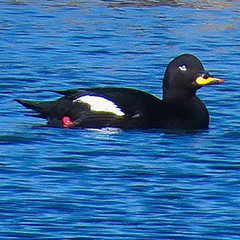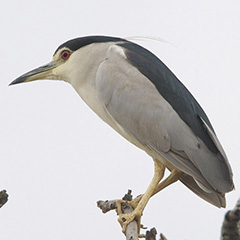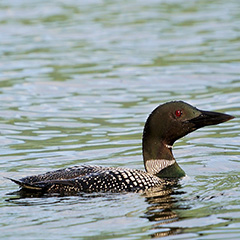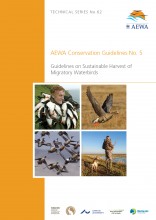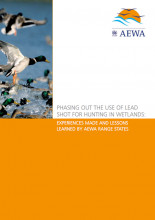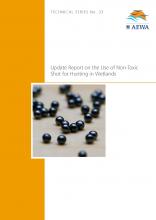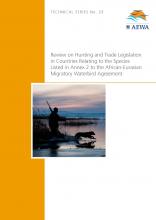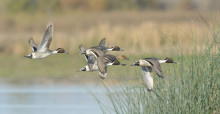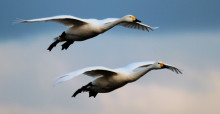Waterbirds and lead poisoning: an overview
Since its inception, the Agreement on the Conservation of African-Eurasian Migratory Waterbirds (AEWA) has been concerned with the issue of lead poisoning. In wetlands used as habitat by waterbirds that are hunted, lead shot is a particular problem as each cartridge contains 100s of pellets, but very few strike the target bird. The rest fall to the ground or into the water where they are ingested by birds which mistake the pellets for food or for the grit needed for their digestion in their gizzards.
Fact - lead shot pellets:
A lead shotgun cartridge typically contains 200-300 pellets weighing a total of 30 grams – an average hunter fires between 3 and 6 cartridges for every hit - but only a few pellets strike the target
Deaths from ingestion of lead shot become apparent either as large-scale die-offs or as less conspicuous day-to-day mortality. Many cases of die-offs have been recorded in the USA and Canada but while headline-grabbing they are probably less important than largely unnoticed small numbers of birds dying every day. Sick and dying birds tend to become reclusive and hide away and their carcasses are easy pickings for predators and scanvegers which can then suffer secondary poisoning. Birds of prey and scavengers are also exposed to lead from eating prey or carrion which contain bullet fragments or embedded shot (from having been previously shot at but not died).
Facts - primary and secondary poisoning:
Before the ban on lead ammunition over wetlands an estimated 40 per cent of North American waterfowl ingested shot during a single season of exposure to lead. Lead poisoning is a significant cause of mortality in raptor species such as Bald Eagles (Haliaeetus leucocephalus).stern Marsh Harrier (Circus aeruginosus) in France and the Calfiornia Condor (Gymnogyps californianus) in the Western USA, which consume animls and carrion containing embedded shot or bullet fragments.
Waterbirds have no teeth. They eat grit to help the grinding process in their gizzards. This process reduces the pellets and the action of stomach acid causes the ingested pellets to dissolve and be absorbed into the blood stream impeding the production of haemoglobin, leading to anaemia. It also affects the nervous, immune, reproductive and circulatory systems, liver and kidneys.
Fact – typical effects of ingesting lead pellets on birds:
10 or more pellets – acute lead poisoning – death in a few days. 2-10 pellets over time– death or chronic poisoning – drooping wings, green, watery faeces, weight loss and abnormal behaviour, reduced ability to forage or escape predators. One pellet – possible death (depending on species), likely adverse effect on immune system and fertility.
Use of lead ammunition is a classic example of the unwise use of natural resources, because lead is a highly poisonous heavy metal which can cause anaemia as well as damage to the nervous and circulatory systems. Swallowing even a single pellet can compromise a bird’s immune system and ability to store energy, with potentially lethal consequences for example, when the animal starts migration.
Fact - tonnes of lead deposited:
Before the ban on the use of lead shot was introduced, 2,000 tonnes of lead were deposited each year on Canada’s wetlands. In the EU alone, several 10,000s tonnes of lead ammunition is irretrievably deposited into the environment every year.
Of the 150 migratory waterbird species listed under AEWA that regularly occur within the EU, 100 are vulnerable to poisoning from spent lead shot. These include ducks, geese, swans, grebes, flamingos, rails, gallinules, coots, cranes, loons/divers, storks, ibises, spoonbills, oystercatchers, avocets, stilts, plovers, sandpipers, snipes and skuas.
Humans do not have muscular gizzards, so less lead from a shot pellet is absorbed if consumed. Pellets can pass straight through the digestive system with only a little dissolved in the acidic stomach (although occasionally there have been reports of people with lead pellets accumulated in their appendix). Most human exposure is from eating smaller pieces and particles of lead ammunition shot into game or lead which has dissolved during the cooking process. The meat of affected birds is a potential hazard as 15 per cent of waterfowl killed have higher lead levels than the accepted safe health standard of 0.5 mg per kg of meat. Some samples showed the level exceeded by a factor of 1,500.
Studies of subsistence communities, for example in Greenland, established connections between high blood lead levels and consuming lead-contaminated game (mainly eider ducks). Since this work more research from different parts of the world has been undertaken. This has led to health protection agencies warning of the particular risks of eating lead-shot game for pregnant women and children, as well as high consumers of game meat – most typically hunters and their families.
Lead and its Uses
![]()
With an atomic number of 82, lead (chemical symbol Pb from the Latin plumbum, hence the term “plumbing” meaning pipes and drains) has been mined since pre-historic times. Its physical properties and cheapness made it highly sought-after for construction, water pipes, batteries, coins, solders, pewter, radiation shields and, significantly for AEWA, ammunition. It is, however, also highly toxic, and it has therefore been phased out for most domestic uses and controlled in industrial uses. Lead can damage the nervous system and causes brain, kidney and blood disorders. It is particularly dangerous for children due to its effects on the developing brain. The first legislation aimed at addressing lead poisoning was enacted in the United Kingdom in the late nineteenth century and the number of cases fell dramatically in the first half of the 20th century. There were even publications dating from the late 19th century about lead poisoning causing death in specimens of ducks, geese, swans and pheasants.
Brief History of Lead Production
In 2016 the top five countries for lead production were China (2,400,000 tons), Australia (500,000), USA (335,000), Peru (310,000) and Mexico (250,000) (source US Geological Survey 2017). In Ancient Times, Greece and Asia Minor were the main areas of production. The Phoenicians developed mines in Spain, Cyprus and Sardinia and the Romans exploited resources in Central Europe, the Balkans and Britain. In Medieval Times, production across much of Europe declined, with the exception of Moorish-ruled Spain. At this time, production in India and China expanded. With the Industrial Revolution, lead production increased again with the United Kingdom leading the way, but as its mines became exhausted, it was overtaken first by other European countries such as Germany and Spain and later by the USA. The lead mining industries in Canada, Australia and Mexico also became significant.
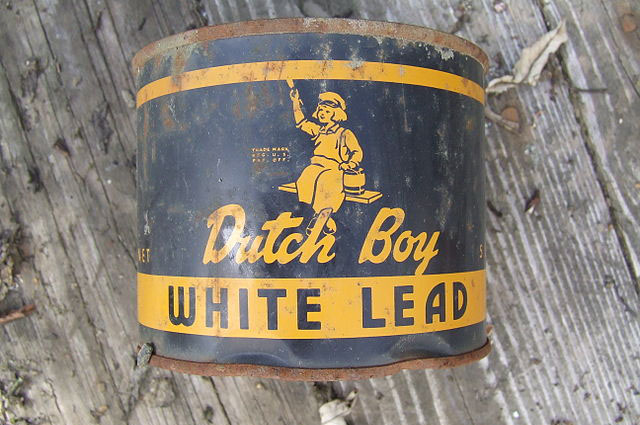
Paint
addressed
Lead was added to paint as it accelerates the drying process, makes the coats longer-lasting and prevents corrosion by repelling moisture. Lead was also a component of many paint pigments such as chrome yellow and red lead. Lead was banned from household paints in much of Europe in the 1930s with the USA following in 1978. Nowadays, lead-free alternatives are available on the market even for traffic markings.
Image: "Dutch Boy Paint logo (front)" by Thester11 is licensed under CC BY 3.0
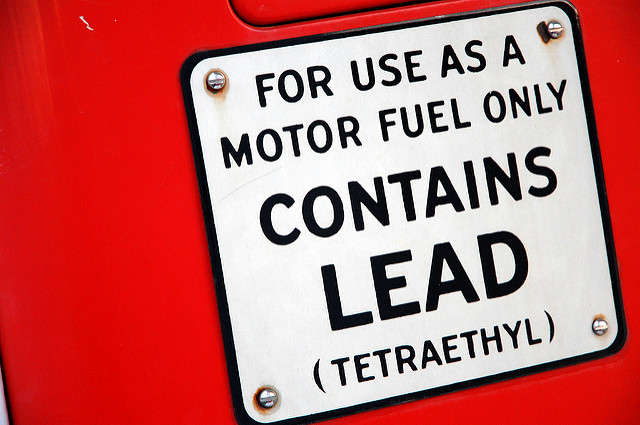
Petrol
addressed
Lead was first added to petrol in the USA in the 1920s in order to reduce “knocking” (petrol igniting before the sparking plugs fire). This was the greatest source of exposure in humans to lead in the second half of the 20th century. By the beginning of the 21st century leaded petrol had been phased out in the USA and the EU.
Image: "CONTAINS LEAD" by Steve Snodgrass - own work is licensed under CC BY 2.0
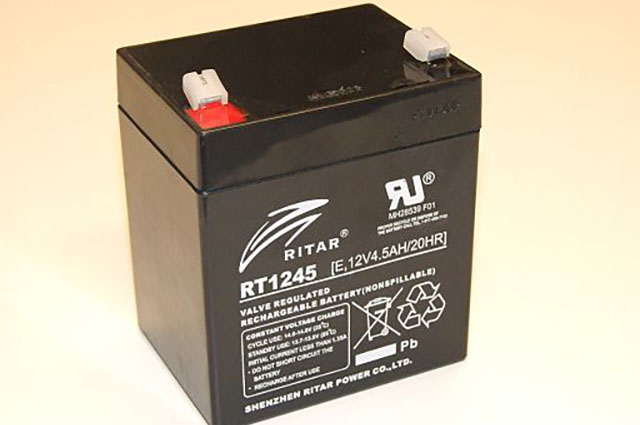
Lead-Acid Batteries
partially addressed
There is little direct risk to human health from day to day use of lead-acid batteries, the main problem being the safe disposal of the batteries after the end of their useful life.
Image: "12V VRLA Battery" by Dudinyúl is licensed under CC BY 3.0
![Lead Ammunitions - Photo by By Lamiot (Own work) [Public domain], via Wikimedia Commons](/sites/default/files/uploads/thematic_pages/lead/LeadPlombs_contenu_1_cartouche_by_Lamio_publicdomain.jpg)
Ammunition
still to be addressed
Lead has been used to make ammunition because of its low cost, ready availability, low melting point and malleability, which make it easy to work with, and high density which allows it to penetrate more deeply into the target. Lead is suitable for most guns apart from high velocity weapons where the softness of the metal hampers performance.
Image: "LeadPlombs contenu 1 cartouche" by Lamiot is licensed under Public Domain
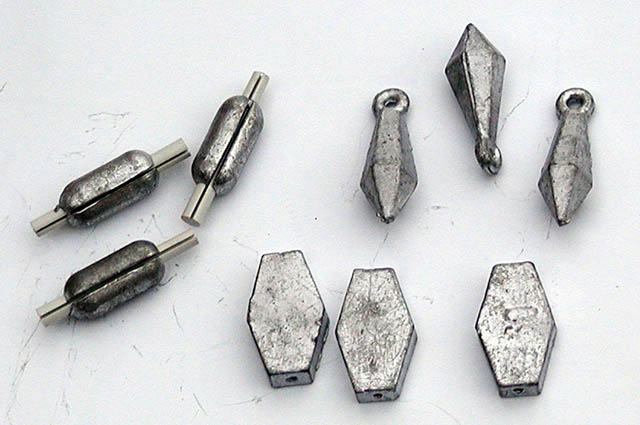
Fishing Weights
still to be addressed
Its high density, low cost, ready availability, easiness to use and form and resistance to corrosion all contributed to making lead the material of choice for fishing weights. However, discarded or lost weights are mistaken for food or grit by waterbirds, leading to lead poisoning.
Image: "verschiedene kleine Grundbleiformen" by RaBoe/Wikipedia is licensed under CC BY 3.0
Measures to address the lead poisoning of waterbirds
Alternatives to Lead Ammunition
Alternatives to lead shot include steel, bismuth, tungsten and alloys of these metals. They have different properties and there are advantages and disadvantages with all of them. Others such as zinc are toxic to wildlife and tin is too light. Tungsten mixed with a polymer is considered superior and quite comparable to lead but costs approximately 10 times more. Steel is harder than lead, and although some hunters are concerned that this increases the likelihood of pellets ricocheting off hard surfaces, others would say an unsafe shot is unsafe regardless of the material (and there has been no increase in the number of accidents reported in Denmark where lead shot has been banned). Steel is harder and therefore does not deform as easily and this allows for a more uniform shot column and often higher penetration of the shot as it does not deform when it hits the plumage of the quarry bird, adding to its effectiveness.
There is little evidence to support some hunters’ claims that non-lead ammunition damages their guns. Most manufacturers recommend checking guns regularly regardless of ammunition used. Muzzle velocity not shot material is the main factor in effective shooting.
Status of Prohibiting the Use of Lead Ammunition
National Report Analysis 2012-2014
In relation to Target 2.1 (the use of lead shot for hunting in wetlands to be phased out in all Contracting Parties), Parties were asked whether they had phased out the use of lead shot for hunting in wetlands. A total of 22 Parties (56% of those responding representing 31% of Contracting Parties overall) reported that lead shot has been fully (17 Parties; 44% of those responding) or partially (5 Parties; 13% of those responding) phased out in their country (Figure 5.3; Table 17 in Annex). Twelve Parties (31% of those responding, representing 17% of Contracting Parties) confirmed that lead shot has not yet been phased out, indicating that more work is needed to meet Target 2.1.
Factors working against switching from lead to non-toxic alternatives
- Poor awareness or disbelief that spent ammunition is a hazard
- Issue not considered important enough
- Lack of finance, expertise or logistics
- Unknown scale of the problem
- Slow bureaucracy
- Lead poisoning not high priority (vs civil war, unrest, transition)
- Non-toxic shot is unavailable or considered too expensive
- Manufacturers have little incentive to switch to non-toxic alternatives
- Poor communication with stakeholders, primarily hunters
- Social-political aspects
Regarding costs, assessments in USA suggest that ammunition accounts for just 8.5% of a hunter’s expenditure.
Effects of Banning Lead Ammunition in Wetlands
Studies in the USA found dramatic falls in levels of lead toxicosis in waterfowl within a short time of the ban in wetlands entering effect. In Canada, studies showed lead levels fell quickly after the ban and a high level of compliance on the part of hunters. Conversely, for the American Woodcock Scolopax minor a woodland species which could still be hunted with lead shot lead levels remained high as hunters maintained old hunting practices.
Species affected by ingestion of lead emanating from discarded fishing weights
Preventing Poisoning of Migratory Birds Working Group
The terms of reference for the Working Group (Annex to Resolution 11.15 (Rev.COP12) set out its remit which is to support implementation of the Preventing Poisoning Guidelines and to assess other causes of poisoning of migratory birds. The membership of the Working Group includes representatives of the CMS Scientific Council, the AEWA Technical Committee, the Raptors MOU Technical Advisory Group and the Bern Convention Expert Group on Birds.
The Working Group developed a comprehensive ecological review of the impact of lead posioning as well as the Guidelines to Prevent the Risk of Poisoning to Migratory Birds, which were adopted at CMS COP11 in 2014. The Guidelines set out the priority areas of poisoning. The following key recommendations emerged from the first Meeting of the Preventing Poisoning Working Group held in Tunis, 27-28 May 2013 (the fifth and sixth recommendations refer specifically to lead):
i. Substitute insecticides with a high risk to birds with safe alternatives.
ii. Restrict/ban the use of second-generation anticoagulant rodenticides.
iii. Prohibit the use of poison-baits for predator control and improvement of enforcement legislation.
iv. Prohibit the use of veterinary diclofenac for the treatment of livestock and substitute with safe alternatives.
v. Phase-out the use of lead ammunition across all habitats within the next three years, with countries reporting on progress to COP12 in 2017.
vi. Phase-out the use of lead fishing weights in areas where migratory birds have been shown to be particularly at risk i.e. freshwater habitats.
As proposed by the Conference of the Parties, the Working Group supports and monitors the implementation of the Preventing Poisoning Guidelines and assesses other causes of migratory bird poisoning.



![Mute Swan By Yerpo [CC BY-SA 3.0 (https://creativecommons.org/licenses/by-sa/3.0) or GFDL (http://www.gnu.org/copyleft/fdl.html)], from Wikimedia Commons By Yerpo [CC BY-SA 3.0 (https://creativecommons.org/licenses/by-sa/3.0) or GFDL (http://www.gnu.org/copyleft/fdl.html)], from Wikimedia Commons](/sites/default/files/uploads/thematic_pages/lead/Mute_swan_Vrhnika.png)
![Goosander Mergus Merganser By DickDaniels (http://carolinabirds.org/) [CC BY-SA 3.0 (https://creativecommons.org/licenses/by-sa/3.0) or GFDL (http://www.gnu.org/copyleft/fdl.html)], from Wikimedia Commons Goosander Mergus Merganser By DickDaniels (http://carolinabirds.org/) [CC BY-SA 3.0 (https://creativecommons.org/licenses/by-sa/3.0) or GFDL (http://www.gnu.org/copyleft/fdl.html)], from Wikimedia Commons](/sites/default/files/uploads/thematic_pages/lead/Common_Merganser_female_RWD.png)
![Mallard - By Keith (Flickr: DSC06489) [CC BY 2.0 (https://creativecommons.org/licenses/by/2.0)], via Wikimedia Commons Mallard - By Keith (Flickr: DSC06489) [CC BY 2.0 (https://creativecommons.org/licenses/by/2.0)], via Wikimedia Commons](/sites/default/files/uploads/thematic_pages/lead/512px-Landing_mallard.jpg)
![Pochard By Tony Hisgett from Birmingham, UK (Pochard 2) [CC BY 2.0 (https://creativecommons.org/licenses/by/2.0)], via Wikimedia Commons Pochard By Tony Hisgett from Birmingham, UK (Pochard 2) [CC BY 2.0 (https://creativecommons.org/licenses/by/2.0)], via Wikimedia Commons](/sites/default/files/uploads/thematic_pages/lead/512px-Aythya_ferina_Sandwell_2.jpg)
